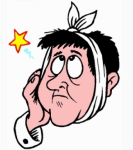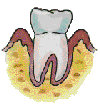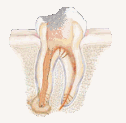
Pain after a root canal treatment
When you have a condition that requires endodontic treatment (root canal therapy), you will already have some degree of irritation of the dental and periodontal tissues. The root canal procedure itself can also cause some irritation. Therefore some root canal pain after the procedure, usually a mild dull pain, is quite common and certainly not alarming. Most patients experience a tender tooth for the first days after treatment.
Causes of Post Root Canal Pain
If the pain after root canal is intense, this could be a sign of complications and possibly of a root canal failure. In about one percent of the cases further treatment or even tooth extraction may be required to relieve the root canal pain.
If you wonder how it is possible for the tooth to hurt after the tooth nerves have been removed, you should know that it is usually the periodontal tissues that cause the post root canal pain and not the treated tooth. The only exception is in cases of failed root canals when the tooth hurts because the nerves are not successfully removed.
As a general rule, the more painful a tooth was before treatment, the more likely it is that you will experience a stronger tooth pain after the root canal therapy. The most common causes of post root canal pain include:
- Irritation of periodontal tissues. The existing inflammation of the periodontal ligaments around the root tips of the infected tooth is the most common cause of tooth pain after root canal treatment. The periodontal tissues may be also get irritated by over extension of an endodontic file beyond the tip of the root during the procedure, as well as by the forcing of debris and fluids beyond the tip of the root during the cleaning of the root canals. The increased blood flow during the healing process of the periodontal tissues is another cause of feeling tenderness and tooth pain.
- Hyper occlusion – If the restoration has made the treated tooth longer that it should be (hyper occlusion), it may hit on the opposing teeth affecting normal biting and causing post root canal pain.
The dentist must correct the occlusion by shortening the tooth, so that it does not make contact with the opposing teeth, not only to stop the related pain but also to protect the treated tooth from fracturing.
Sometimes the related symptoms may be only temporary and the tooth may not need any adjustment. This can happen if there is still inflammation around the root of the tooth during the first days after treatment. The inflammation may elevate slightly the tooth beyond its normal height causing a temporary hyper occlusion problem. - Bruxism – Patients with bruxism problems may face root canal pain if they continue to grind or clench their teeth after the root canal therapy. The treated tooth that is already irritated by the infection and the treatment may become severely inflamed and painful, or even crack under the forces of teeth grinding.
- Infection - Periapical abscess (concentration of pus and fluid at the tip of the root). A new abscess may be formed as a result of a bone infection due to bacteria that were forced beyond the tip of the root prior or during the endodontic procedure infecting the jaw bone. The pressure on the tissues surrounding the tooth roots is increasing, causing pain and sometimes swelling. The dentist must be certain that the infection is fully eliminated before the tooth is restored. If the infection remains it increases the risk of post treatment pain and root canal failure.
- Sterile abscess - In some cases, another type of abscess may be formed by small amounts of the fluid that is used to clean and sterilize the canals pressed beyond the tip of the root during the root canals cleaning. As in the case of a periapical abscess, a sterile abscess can cause significant post treatment discomfort. The dentist must ensure that there is no fluid around the roots before permanently filling the tooth. Failure to drain and properly disinfect the periapical area may result in severe post root canal pain.
- Ghost Pain. Another type of pain after root canal are the so called ‘ghost pains’ which are common after an amputation. In the case of root canal therapy, the nerves inside the tooth are amputated. The patient may feel a ghost pain in the tooth for the same reasons that an amputee may experience pain in the fingers of an amputated hand. This type of pain normally goes away on its own in a few days and it is no cause of worry. The problem related with ghost root canal pain is that it may confuse the dentist if there is a root canal complication or not.
- Failed root canal. Tooth pain after root canal treatment that is excessive and does not go away after a few days is not a normal symptom and it is usually a sign of root canal complications.
A failed root canal should be suspected if:
- you do not see an improvement and continue to feel pain as before treatment
- post-operative toothache persists or worsens
- you notice signs of re-infection in the tooth such as swelling, fluid accumulation or drainage.
- the tooth feels very sensitive to cold
- the tooth feels normal for some days after the procedure and later it starts to hurt again.
The most common causes of post root canal pain due to treatment complications are:
- A root canal is not cleaned properly. Infected tissue is left inside the tooth.
- The tooth is perforated during treatment allowing bacteria to enter the tooth, a possible complication when the root is curved.
- The root canals are not completely filled and sealed
- An instrument, usually a root canal file, is broken inside a canal.
Remedies for Root Canal Pain Relief
The normal post root canal pain can be relieved by taking an over-the-counter pain reliever, usually an anti-inflammatory medicine like Ibuprofen. Sometimes an antibiotic is also prescribed to minimize the risk of a new infection.
Occlusion problems should be corrected by reducing the treated tooth as soon as possible to prevent further inflammation of the tooth that could lead to more complications.
If there are signs of infection antibiotics will be prescribed. If an abscess is formed, post root canal pain can be relieved temporarily by providing drainage, but the treatment will more probably have to be repeated.
In case of a failed root canal pain, a re-treatment and possibly an apicoectomy are needed in order to save the tooth. If neither proves to be successful a tooth extraction is necessary. A stronger prescription pain medicine may be needed for post root canal pain relief until the tooth is re-treated or extracted.
Prevention of Pain after Root Canal Treatment
The root canal therapy may require several appointments until it is completed. The tooth can not be filled before the infection is fully eliminated. Under certain conditions you may have to deal with some amount of root canal pain between the dental appointments:
- Follow your dentist’s instructions for post-operative care. Good oral hygiene will help in faster healing. Take any antibiotics according to your dentist’s prescription.
- Immediately after the root canal procedure, the tooth is tender. Eat soft foods for the first days and avoid to chew hardly on the treated tooth.
- If the dentist has not yet placed the final restoration, the tooth is fragile and it may crack or fracture under pressure.
- If a temporary filling that is placed to protect the tooth before appointments is lost, visit your dentist immediately to replace it, otherwise the tooth may get re-infected resulting in additional root canal pain.
- If you feel that your teeth do not bite properly and the treated tooth hits on opposing teeth, visit the dentist to repair it and avoid further complications.
- More articles about Root Canal Therapy
next page -> ► Tooth Pain After Filling

 Dental Insurance
Dental Insurance Sensitive Teeth Pain
Sensitive Teeth Pain Tooth Abscess Pain
Tooth Abscess Pain Tooth Extraction Pain
Tooth Extraction Pain Toothache Medicines
Toothache Medicines